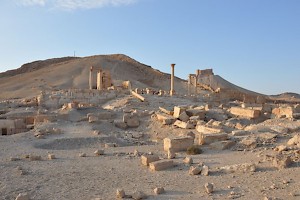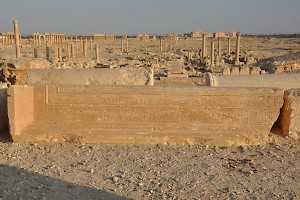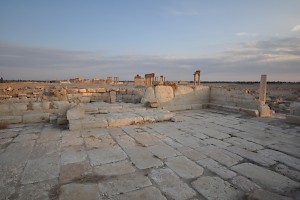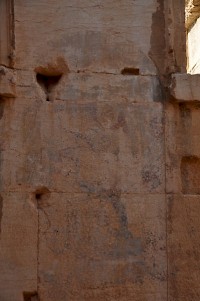Palmyra (5)
Q5747Palmyra or Tadmor: oasis in the desert between Damascus and the Euphrates, important trade center, and capital of a semi-indepent state in the third century CE.
Late Antiquity

The emperor Aurelian left behind a garrison in Palmyra: the First Legion of the Illyrians, which had only recently been recruited among the inhabitants of the Latin-speaking provinces along the Danube. As a non-oriental element without local ties, this unit could be relied upon. The “Diocletianic Camp”, immediately west of the city, was to serve as its base and we know that this unit was still there when, at the beginning of the fifth century, the document known as the Notitia Dignitatum (a list of magistracies and army units) was composed.

In the final decade of the third century, the whole eastern frontier was redeveloped: new roads were built, new forts constructed. Essentially, the old system of defense had consisted of a line of fortifications along the border, but this carried a certain risk: if an enemy broke through, as Shapur had done, he could easily proceed hundreds of kilometers into the interior. The new defensive structure was a network of forts (“defense in depth”) and the Arab sector was called Strata Diocletiana, after the emperor who created it, Diocletian (r.284-305).
He was also responsible for the latest known civil building in Palmyra: the Diocletianic Baths. Leaving their fort, the soldiers only had to walk along the old colonnaded street to take a bath and relax. It must have been a strange place: most of the city lay abandoned, and because Nisibis was now the main trade station, there was no hope that Palmyra would ever become an important city again.

Diocletian is known as one of the persecutors of Christianity, but in 311, his successor Galerius put an end to this policy, and his successor Licinius even compensated the Christian churches: property that had been taken away, was restored, and bishops were accepted as people of great importance. Palmyra’s first church dates from these years. We know that a bishop named Marinus attended the Council of Nicea in 325, in which Licinius’ successor Constantine tried to unify the divided Christian world.

It would be wrong to think that Palmyra was now an abandoned city, inhabited by the soldiers of I Illyicorum only, but we have little evidence. It is reasonably certain that the old temples were taken over by Christians: in the first half of the fifth century, this happened to the temple of Ba’al Šamim. The Christian frescoes in the temple of Ba’al are also from the fifth century. We read that the emperor Justinian (r.527-565) rebuilt the city wall of Palmyra,note and two other churches seem to belong to this age as well.
In 634, the Arab general Khalid visited the oasis and accepted Palmyra as part of the world of Islam. We know that there were mosques in the former shrine of the imperial cult (the Caesareum), while the Christian church in the former temple of Ba’al was at some stage also converted into a mosque. The fact that we know only two mosques, however, suggests that at this moment, Palmyra was a small town. A part of the Colonnaded Street had been converted into a bazar by building a roof across the street (more or less as happened in Damascus), and there were people living among the ruins, but it was a poor settlement.

The deepest cause of this decline was that Syria and Iraq were now ruled by one and the same dynasty: first the Umayyads, then the Abbasids. The Euphrates-Orontes route had always been an alternative for the desert route, but now, there were other alternatives, deeper to the south, where the “desert castles” of Jordan became increasingly important.